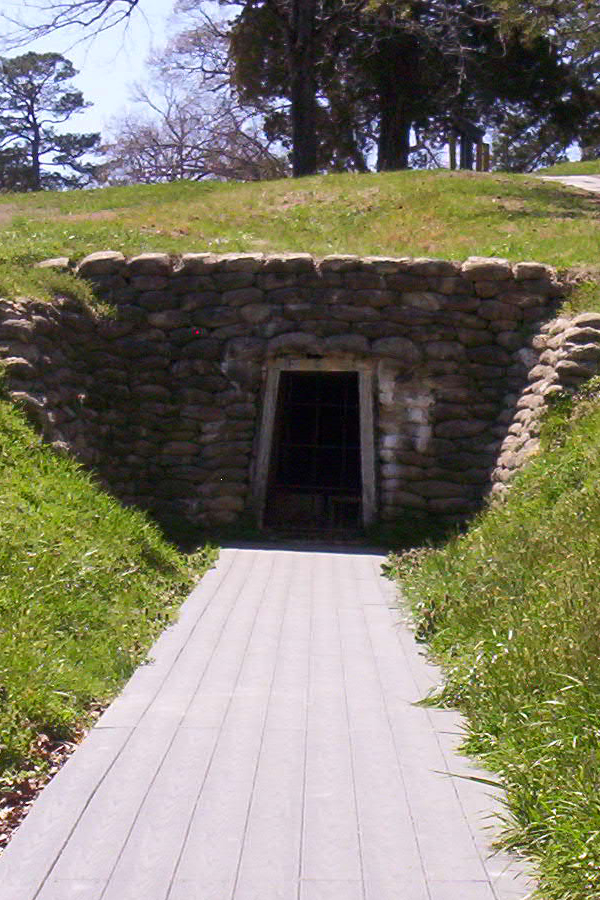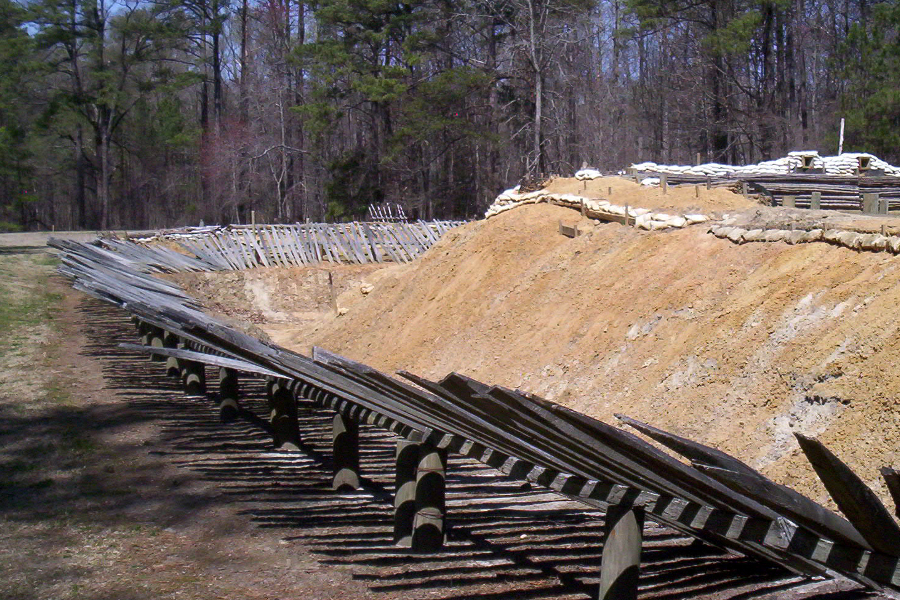
Photo above: Soldiers behind defenses at the siege of Petersburg, courtesy Library of Congress. Right: Reenactors at Petersburg National Battlefield, courtesy National Park Service.

Petersburg
It was the longest siege of the Civil War, taking over nine months to complete, beginning when General Ulysses S. Grant would push south after his defeat at the Battle of Cold Harbor, reaching Petersburg on June 15, 1864. General Robert E. Lee would actually show up three days later and begin to defend the city and its supply lines to Richmond. Battles would continue until the final breakthrough of those defenses on April 2, 1865.
Click here to Sponsor the page and how to reserve your ad.

Petersburg Then
It's a siege with plenty of battles within it as Grant tried to cut off supply lines and Lee tried to prevent that. Some of those battles have reached the stage of lore, i.e. the Battle of the Crater, as well as the final Battle of Five Forks. Others were important pieces of the puzzle, all fitting in a tightening of the noose that Grant was trying to achieve and eventually did. It's hard to keep it all in context and somewhat hard to visit as the park is spread out around the city all the way to the James River. And the final piece, the actual Petersburg Breakthrough, is not within the Petersburg National Battlefield itself, but in the private Pamplin Historical Park. That might have something to do with why the Petersburg Battlefield does not get as much credit, visitation, or love as some of the others in the war, but that does not diminish its importance. It would lead to the end of the war.
There are so many stories and battles surrounding the siege of Petersburg and those nine plus months that it is hard to focus on a few, but we'll pick two, and probably two of the better knwon; the Crater and the Battle of Five Forks.
The Battle of the Crater - If it were in the context of a made up movie, you wouldn't believe it. How soldiers who were miners turn into miners again, dig a tunnel, plant explosives, then blow up their enemy above. And, in the end, the ones who blew up their enemies, lost the battle. Go figure. It started in late-June when the 48th Pennsylvania Infantry with a miner at its head, Lt. Colonel Henry Pleasants, took an idea to his Corp commander Burnside, then dug under the Confederate First Corps. On July 30, the mine was exploded, but the subsequent attack failed as Union troops, included USCT troops, dipped into the crater. Union losses were two and one half times greater than the Confederates.
The Battle of Five Forks - Now this action should really get more credit in the annals of Civil War history, but it gets lost in the shuffle of Lee and Grant at Appomattox, which it directly led to. On the southern end of the Petersburg lines, General Sheridan and his soldiers fresh from their days in the Shenandoah Valley, plus the Union 5th Corops under General Warren, would fight against General Pickett of Gettysburg fame in a showdown of forces to take the crossroads there and the Southside Railroad on April 1, 1865.
Photo above: View from the interior of the Petersburg defenses at Stop #3 of the Eastern Front auto tour. Photo below: Boardwalk bridge into the outer defenses of the Petersburg line.

Petersburg Now
Petersburg National Battlefield - As noted above, the Petersburg battlefield is spread out over three counties and thirty-three miles, but a good place to start in the Eastern Front Visitor Center. From there, you can find out about Battle Walks at all locations, or head out with a tour map on that thirty-three miles journey of thirteen sites and three visitor centers in all. This will take you to City Point where Grant was headquartered and down to the Five Forks Battlefield where the final great assaut would lead to Lee abandoning the city.
Pamplin Historical Park - Pamplin is a private historical park founded in 1993 by Portland businessman Robert B. Pamplin, Jr. It is not associated with the National Park, but does include the preservation of the historic district of the Petersburg Breakthrough Battlefield, where the final Union breeching of the Confederate fortifications and trenches on April 2, 1865 led to the abandonment of Petersburg. The Park also has a National Museum of the Civil War Soldier, established 1999 as well as three historic homes and three other museums. A visit here takes two to four hours to see it all.
Minute Walk in History
Siege of Petersburg 1864
Through a number of campaigns, the first, the Bermuda Hundred battles by the Army of the James which occurred while Grant and Lee fought the battles of the Wilderness and Spotsylvania, and later, in the fall, after they had both arrived, the Battle of Hatcher's Run or Boynton Plank Road, we travel to many little known places where both of those battle occurred. And for those who like intact earthworks, don't miss the pictures from Hatcher's Run. So intact. They are awesome. Narration by Jason Donovan from the Official Report of the Civil War.
Minute Walk in History
Petersburg National Battlefield Tour
Follow along as I, and a Civil War historian friend, travel the tour road to Battery Five, Fort Stedman, and the other sites within the park. Also take the one mile walk a bit outside the park along American Battlefield Trust land and the Union walk to the breakthrough. Backed up the Civil War sounds, plus the somber tones of the Civil War tune, Somebody's Darling by Kathy Mattea. Courtesy Sony Music.
Minute Walk in History
Petersburg Breakthrough 1865
Walk through the Union attack line from Fort Welch, a rarely visited one mile view and trail of how Grant's troops made their final assault on the Confederate's tough and deep trenches now in the woods and follow that with the site, in Pamplin Park, a magnificent Civil War era site to visit, of the Confederate side. Also included later action of this day, April 2, 1865, as Union troops spread through the lines to Fort Gregg.
T-Shirts and Souvenirs

Battle of Petersburg Civil War T-Shirts and Souvenirs. Official gear from America's Best History.

Petersburg
Things You Should Not Miss
1. Grant's Headquarters at City Point. This is the north and east location of the park and if you go here first, will not have gone to the main visitor center of the Eastern front that has the movie and better orientation, but ... don't miss this part. No, it's not about the battle per se, but it is on the James River, includes a plantation, now a lot smaller than during the 1860s, as well as the history of Grant, Lincoln, and the end of the war.
2. Tour stop #3 Eastern Front. Now this is what Petersburg is all about. Steep walls, pointy sticks, and an real understanding of how difficult it would be to overrun. Outside all the walks and talks, this is likely the location where you'll understand just what went on here.
3. After getting that plan and if a tour is within your timeframe and held on the day of your visit, take any available Crater Battle Walk. It's at Tour Stop 8 and such a fabulous story. Don't miss it if it's available.
4. Visit the Five Forks Visitor Center. It may be as important as at any national battlefield to get the lay of the land around Petersburg due to its dispersed nature. Take an hour or so to see the exhibits there plus the short film, find out if there are any upcoming battle walks and talks. Even though the area of interpretation where the self-guided tour isn't too large, it's a ping pong approach between the markers and a bit confusing, probabloy like the battle. Five Forks is at the end of the auto tour and thirty-three miles is a lot of area to cover. Good to have a plan.
Photo above: Current view of the Eppes Plantation house at City Point. The plantation was the headquarters for the Union Army during the Petersburg siege.

Get Baseball History and Books at Stat Geek Baseball, including Fields of Gold, Baseball's Best Glove Work.





